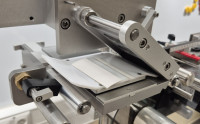Few in the confectionery industry are likely to have ever given more than a passing thought to the splice process that forms part of the packaging line. However, this seemingly unremarkable step is key to overall efficiency. Using a smart solution here can save you significant sums of money. Every packaging line in the confectionery industry begins with a roll of packaging web made from a material such as paper, plastic or aluminium.
This is transformed into shrink-wrap bags or sealed pouches, thermoforming containers, or any one of a myriad of wraparound options. However, every roll of packaging web will eventually run out and thus the trick is to create a neat chain of rolls, simulating a never-ending ribbon of material, so that the packaging process can continue uninterrupted. This is where the splicing process comes into play.
One splice solution still frequently found in the industry today involves the tail end of the running web entering a splicing device and, with the help of double-sided tape, being adhered (and fused, in the case of thermoplastic film) in overlapping fashion to the start of a new web. While the procedure itself is automatic, using a mechanical system supported by sensors, the preparation of the splice area with double-sided tape requires manual intervention.
As with fully manual splices, a semi-automated procedure as outlined above calls for a certain buffer reserve to be left in each roll of packaging web, so that the continuous movement does not need to be halted. Where the feed of web comes from alternating sources, the amount of buffer material must be doubled. These buffers account for a significant percentage of the total machine size and, together with the splicing device itself, represent a cost factor within the capital expenditure.
Compared with the processes described above, the JetSplice® splice process, from Verpackungstechnik Jetter GmbH, is amazingly simple. With JetSplice®, the packaging web is prepared by the manufacturer: A special splice tape is attached to the core of the roll, and this gets torn off when the end of the packaging web is reached. As the “running” roll of packaging web is gradually unwound, the machine operator positions the beginning of a new roll in the JetSplice® splice head. The tail end of the old web roll, prepared with splice tape, arrives in the splice head and adheres to the start of the new web, immediately “dragging” it into motion with pinpoint accuracy and without incurring any downtime.
This web in turn becomes the new running web and can be rotated into the appropriate position inside the unwinding device. The splice can be performed in overlapping or end-to-end form. For web speeds of up to 50 m per minute, it is not necessary to factor in any buffer reserve in the web. Higher speeds require at the most a simple buffer in the form of a loop, in order to absorb the jolt that occurs when the new web is dragged into motion. The costs of equipping a packaging machine with this system are correspondingly low.
The JetSplice® system is compatible with material webs of every kind up to a maximum width of 450 mm. The procedure is equally suitable for splicing label web rolls of all kinds, including self-adhesive labels on liner, wet glue labels, hot melt labels and self-adhesive linerless labels.
The webs are connected through the use of splicing tape and the flexible, sturdy splice head designed by Verpackungstechnik Jetter GmbH and produced by the packaging machine specialists b+b Automations und Steuerungstechnik.



